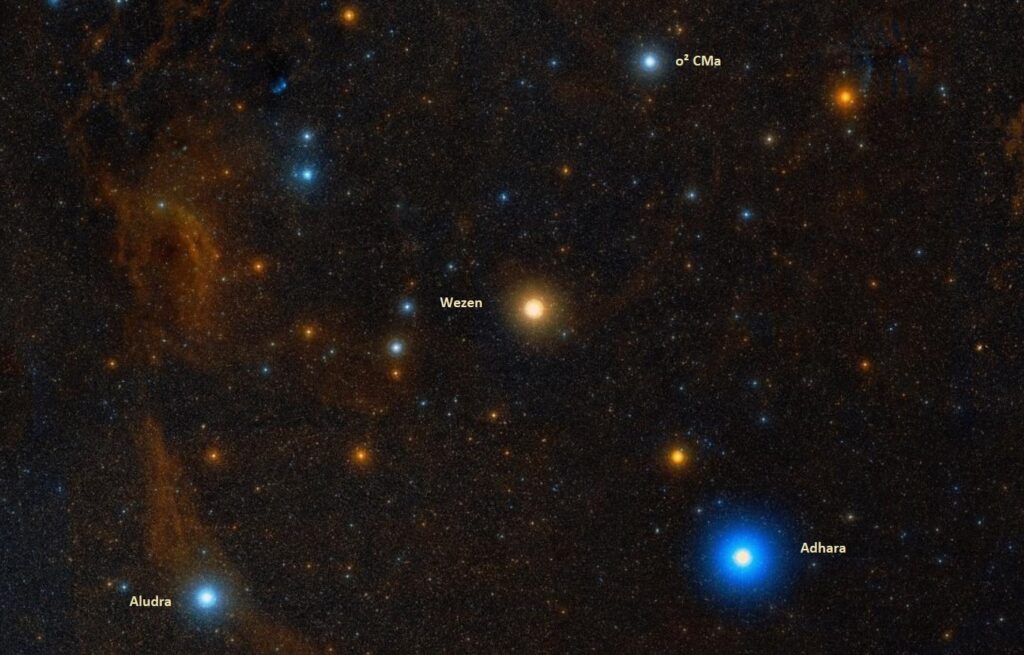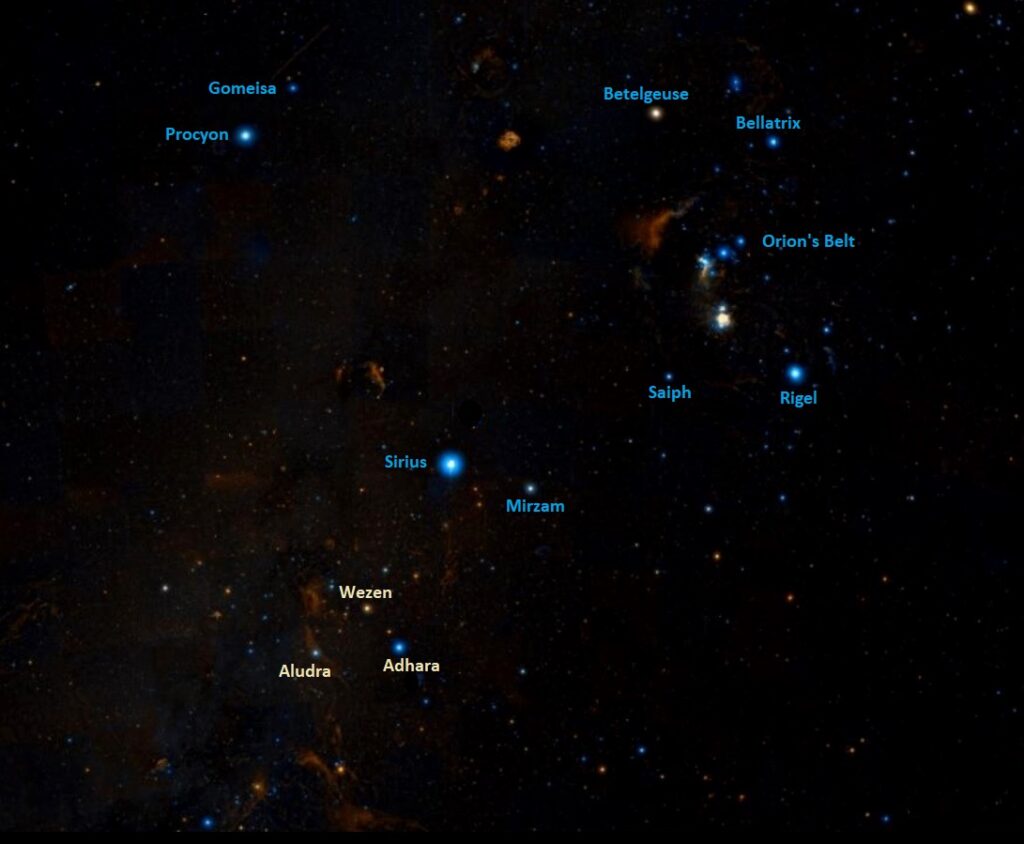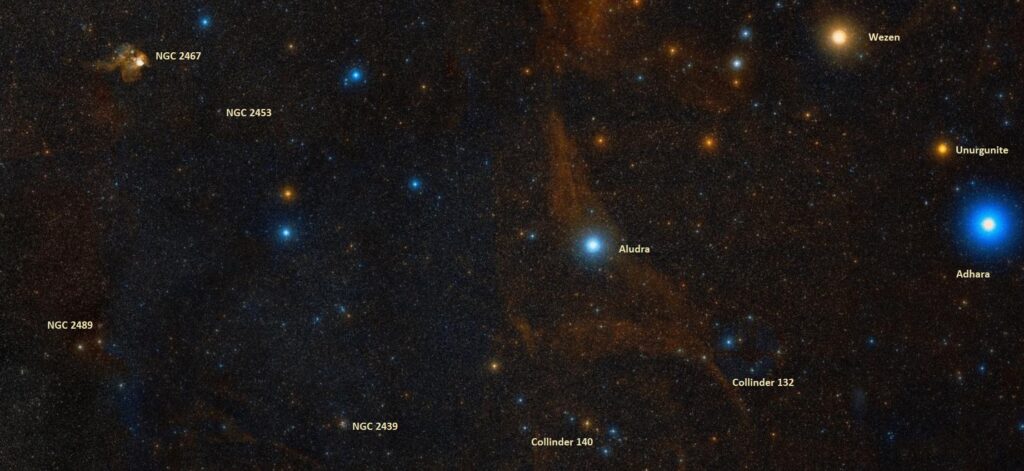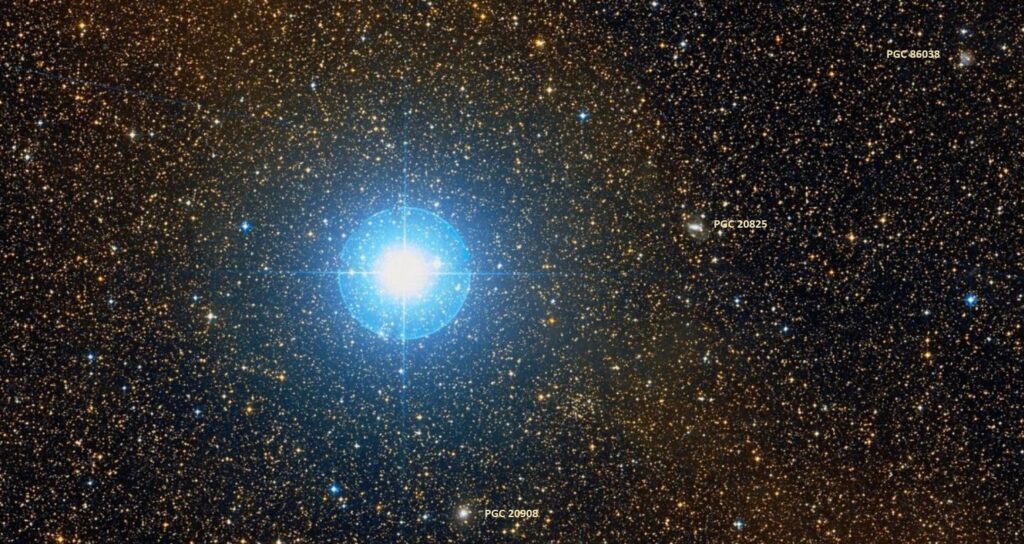Aludra, Eta Canis Majoris (η CMa) is a blue supergiant located in the constellation Canis Major. It marks the Greater Dog’s tail. With an apparent magnitude of 2.451, it is the fifth brightest star in the constellation, after Sirius, Adhara, Wezen, and Mirzam. Aludra lies at an approximate distance of 2,000 light years from Earth.
Star type
Aludra has the stellar classification B5 Ia, indicating a bright supergiant star appearing blue or blue-white in colour. The star has a mass 19.19 times that of the Sun and has expanded to a size of 56.3 solar radii. With an effective temperature of 15,000 K, it shines with 105,442 solar luminosities.
With a mass of 19.19 solar masses, Aludra is certain to end its life in a supernova blast. Even though it is still a young star, it has evolved quickly due to its high mass and is now probably on its way to becoming a red supergiant before it meets its end within the next few million years.
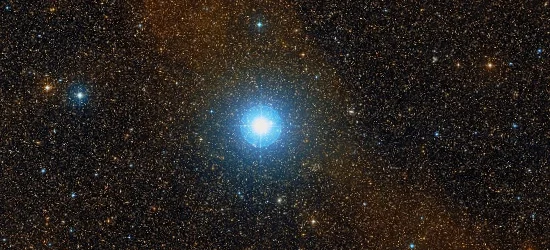
Aludra (Eta Canis Majoris), image: Wikisky
Eta Canis Majoris is classified as an Alpha Cygni variable. Named after Deneb (Alpha Cygni), the prototype for this class, Alpha Cygni variables exhibit variations in brightness due to non-radial pulsations, which means that some parts of their surfaces are expanding while others contract. Other stars of this type include Rigel and Alnilam in the constellation Orion, Rho Leonis in Leo, Kappa Cassiopeiae in Cassiopeia, and Aludra’s Canis Major neighbour Omicron2 Canis Majoris.
The brightness variations in Alpha Cygni stars typically have small amplitudes and appear irregular, with multiple pulsation periods of a few days to a few weeks. The brightness of Aludra varies from magnitude 2.38 to 2.48 over a period of 4.70433 days.
Facts
On average, Aludra is the 88th brightest star in the sky. It is only slightly fainter than Ankaa in the constellation Phoenix, Phecda in Ursa Major, Sabik in Ophiuchus, and Scheat in Pegasus. It just outshines Alderamin in Cepheus, Markeb in Vela, Gienah in Corvus, and Markab in Pegasus.
Even though it is only the fifth brightest star in Canis Major, Aludra is much more intrinsically luminous than its brighter neighbours, but being so distant, it appears fainter. It is 105,442 times more luminous than the Sun, while Sirius shines with 25.4 L☉, Adhara with 38,700 L☉, Wezen with 82,000 L☉, and Mirzam with 26,600 L☉.
Name
The name Aludra (pronunciation: /əˈluːdrə/) has the same origin as the neighbouring Adhara (Epsilon Canis Majoris). It is derived from the Arabic word al-adhraa, meaning “the virgin.” (The name Adhara comes from the plural form of the word.) Aludra, Adhara, Wezen (Delta CMa) and Omicron2 Canis Majoris were collectively known as Al ʽAdhārā, meaning “the virgins.”
The name Aludra was approved by the International Astronomical Union’s (IAU) Working Group on Star Names (WGSN) on July 20, 2016.
In Chinese astronomy, Eta CMa is known as 弧矢二 (Hú Shǐ èr), the Second Star of Bow and Arrow. The Chinese Bow and Arrow asterism is formed by Aludra with Wezen (Delta Canis Majoris), c Puppis, Chi Puppis, Omicron Puppis, k Puppis, Adhara (Epsilon Canis Majoris), Kappa Canis Majoris, and Pi Puppis. The asterism is part of the Well mansion, one of the southern mansions of the Vermilion Bird.
Location
Aludra is very easy to find because it lies near Sirius, the brightest star in the sky, and forms a distinct triangle with two other bright stars, Adhara and Wezen. The triangle lies south-southeast of Sirius. Sirius can be found by extending an imaginary line from the three stars of Orion’s Belt – Mintaka, Alnilam and Alnitak – to the southeast. Both Aludra and the brighter Wezen appear on the imaginary line extended from Betelgeuse in Orion through Sirius. Aludra is the faintest of the three stars that form the triangle asterism.
Aludra can be used to find several relatively bright deep sky objects that lie in the same area of the sky. The open cluster Collinder 140 appears south of the star. With an apparent magnitude of 3.5, it is visible to the unaided eye on a clear night. It stretches across 60’ of the sky and, at a distance of 1,226 light years, it is closer to us than Aludra. Collinder 132, another open cluster, can be seen southwest of the star. It is slightly fainter than Collinder 140, at magnitude 3.60.
Southeast of Aludra, the open cluster NGC 2439 occupies 10’’ of the sky. With an apparent magnitude of 6.9, it is visible in binoculars. It lies in the neighbouring constellation Puppis. The open clusters NGC 2453 and NGC 2489, and the star-forming region NGC 2467, popularly known as the Skull and Crossbones Nebula, are a bit further away.
Three fainter galaxies – PGC 20908, PGC 20825 and PGC 86038 – appear closer to Aludra but can only be seen in larger instruments.
Constellation
Aludra is located in the constellation Canis Major. Representing the larger of the two dogs following Orion, the Hunter, Canis Major is one of the Greek constellations, first listed by the astronomer Ptolemy of Alexandria in the 2nd century CE. It is the 43rd constellation in size, occupying an area of 380 square degrees of the southern sky. Even though it is not one of the larger constellations, Canis Major is easily visible. It contains five stars brighter than magnitude 3.00, including Sirius, the brightest star in the sky. Adhara, Wezen and Mirzam are also among the 50 brightest stars.
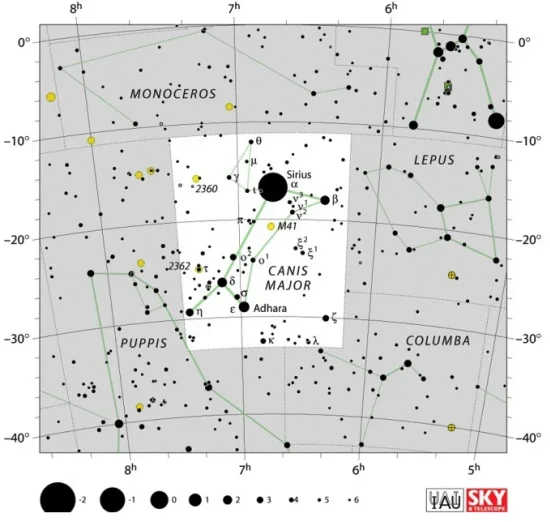
Canis Major constellation map by IAU and Sky&Telescope magazine
Canis Major contains several other notable stars, among others the red supergiant VY Canis Majoris, one of the largest stars known, the carbon star W Canis Majoris, and the blue supergiant Tau Canis Majoris. Tau CMa is the central star of the young open cluster NGC 2362, also known as the Tau Canis Majoris Cluster.
Other bright deep sky objects in the constellation include the open clusters Messier 41 and NGC 2360 (Caroline’s Cluster), the emission nebula NGC 2359, also known as Thor’s Helmet Nebula, the Canis Major Dwarf galaxy, the nearest satellite of the Milky Way to the Sun, and the interacting galaxies NGC 2207 and IC 2163.
The best time of year to observe the stars and deep sky objects of Canis Major is during the month of February, when the constellation is prominent in the evening sky. The entire constellation is visible from locations between the latitudes 60° N and 90° S.
The 10 brightest stars in Canis Major are Sirius (Alpha CMa, mag. -1.46), Adhara (Epsilon CMa, mag. 1.50), Wezen (Delta CMa, mag. 1.824), Mirzam (Beta CMa, mag. 1.985), Aludra (Eta CMa, mag. 2.45), Furud (Zeta CMa, mag. 3.025), Omicron2 Canis Majoris (mag. 3.043), Unurgunite (Sigma CMa, mag. 3.43 – 3.51), Kappa Canis Majoris (mag. 3.40 – 3.97), and Omicron1 Canis Majoris (mag. 3.78 – 3.99).
Aludra – Eta Canis Majoris
| Spectral class | B5 Ia |
| Variable type | Alpha Cygni |
| U-B colour index | -0.708 |
| B-V colour index | -0.087 |
| Apparent magnitude | 2.451 |
| Absolute magnitude | -7.0 |
| Distance | 2,000 light years (600 parsecs) |
| Parallax | 1.64 ± 0.40 mas |
| Radial velocity | 41.1 km/s |
| Proper motion | RA: -4.14 ± 0.29 mas/yr |
| Dec.: 5.81 ± 0.42 mas/yr | |
| Mass | 19.19 ± 1.15 M☉ |
| Luminosity | 105,442 L☉ |
| Radius | 56.3 R☉ |
| Temperature | 15,000 K |
| Rotational velocity | 50 km/s |
| Constellation | Canis Major |
| Right ascension | 07h 24m 05.70228s |
| Declination | –29° 18′ 11.1798″ |
| Names and designations | Aludra, Eta Canis Majoris, η Cma, 31 Canis Majoris, HD 58350, HR 2827, HIP 35904, SAO 173651, PPM 252311, FK5 283, CD−29°4328, GC 9886, GCRV 4922, CPD-29 1680, GSC 06550-04525, ALS 14888, JP11 4549, UBV 7173, MCW 530, TYC 6550-4525-1, IRAS 07221-2912, 2MASS J07240570-2918113, CEL 1826, CCDM J07240-2918A, IDS 07201-2907 A, WDS J07241-2918A |
